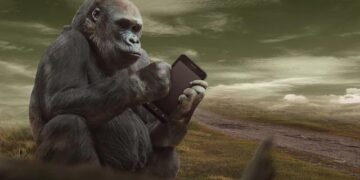ByDina Fine Maron
Published December 6, 2023
• 12 min read
In another stellar year for science, astronomers unveiled new discoveres about the cosmos, biologists etched out a clearer map of our planet’s creatures, and paleontologists painted a richer picture of the dinosaurs that roamed Earth millions of years ago. The latest compendium of humanity’s scientific research continues to intrigue and reveal new mysteries to solve.
Here are some of National Geographic’s top picks for 2023’s most fascinating breakthroughs.
1. Astronomers detect immense ripples in the fabric of space-time
For the first time, scientists detected low-frequency gravitational waves moving through the galaxy. These cosmic ripples are likely the distant echoes of supermassive black holes interacting and merging many billions of light-years away. A consortium of international researchers discovered these cosmic waves by measuring tiny time variations in radio signals from pulsar stars. The findings suggest that there were far more behemoth black holes in the early universe than previously thought, and continuing to study this new type of gravitational wave could help unravel details about the origins of our universe and better explain the unseen substances and forces that power the cosmos.
2. Brain decoder translates human thoughts—providing hope for those who’ve lost speech
Though it’s not technically a “mind reading” device, University of Texas at Austin researchers reported revolutionary work with their new AI-based system—translating a person’s brain activity into a continuous stream of text in the lab. This semantic decoder doesn’t require a surgical implant, but instead it relies on functional MRI scans to pick up brain activity in response to things like podcasts or images. Rather than provide word-for-word transcripts, the brain decoding system essentially creates a dictionary of brain activity patterns based on how an individual responds to certain words or images and then uses that dictionary to cross-reference brain activity to other things that the person is thinking about. This tech, which relies on AI language generation algorithms, is currently in its early days, though it’s already raised thorny questions about mental privacy and ethics in non-voluntary situations. For the families of people with communication impairment, however, the work provides new hope.
3. Ancient whale might be largest animal ever
Move over blue whale—an ancient cetacean appropriately named the Perucetus colossus may have been the largest animal ever. A new analysis of fossil bones from the ancient whale that plied the waters along the coast of Peru more than 37 million years ago suggests that the animal may have weighed more than 300 tons and measured around 60 feet. If it was truly as heavy as scientists suspect, then it would have been the largest known animal to ever live. Blue whales, although still longer at around 100 feet, only weigh around 200 tons.
4. T. rex had lips, changing our picture of this dinosaur
Tyrannosaurus rex and other carnivorous dinosaurs likely had a different pucker than suspected, sporting lips that covered their formidable teeth. A team of paleontologists came to this startling conclusion after studying modern analogs to the prehistoric animals, including birds and reptiles, alongside known details of the dinosaurs’ anatomy. They wrote that T. rex and related meat-eaters likely had soft tissue that covered their sharp teeth to protect the animals’ mouths and keep their chompers in peak condition for attack.
5. 3-million-year-old stone tools reveal ingenuity of our non-human relatives
In southwestern Kenya, archaeologists dug up a surprising find: stone tools buried alongside fossils from the hominin Paranthropus, an ancient non-human relative of our species. The discovery of the tools—which may be up to three million years old—provides evidence that non-human hominins developed stone technologies. What’s more, it suggests tool development occurred earlier than previously thought. Paranthropus had large teeth and jaws, so ideas about their possible stone tool use were largely dismissed because these items wouldn’t have been essential for food processing, Cleveland Museum of Natural History’s paleoanthropologist Emma Finestone told National Geographic. The latest findings appear to upend that assumption.
6. ‘Lost world’ may push back the origins of complex life
Chemical clues extracted from ancient rocks in Australia and elsewhere suggest that sophisticated cells were already commonplace between about 1.6 billion and 800 million years ago, supporting theories of a surprisingly early timeline for the origins of complex life. The evolution of eukaryotes—organisms that possesses a clearly defined cellular nucleus—has proved largely elusive, so an international research team opted for a new tact: hunting for the byproducts of molecules that eukaryotes rely on to form their cell membranes. If they could find such evidence in ancient rock samples, they reasoned, that could serve as evidence of the presence of eukaryotes. Their oldest sample of these molecules, taken from Australia’s Barney Creek Formation, dates back to 1.6 billion years ago—pushing the chemical evidence for eukaryotes back in time to more closely align with genetic and microfossil evidence.
7. Number of discovered planets rises past 5,500
In August, roughly three decades after astronomers found the first planets outside our own solar system, scientists unveiled that they’d discovered six new exoplanets, pushing our total count of known planets above 5,500. The search for exoplanets, enabled by telescopes such as the Transiting Exoplanet Survey Satellite (TESS), continues to reveal a remarkable diversity of new worlds across the galaxy. What’s more, the James Webb Space Telescope and other powerful observatories are also providing more details about these worlds, such as K2-18 b—a planet between the sizes of Earth and Neptune that may have a global ocean beneath a thick atmosphere.
8. Chimps, like humans, experience menopause
Biologists have long puzzled over the evolutionary benefit of animals living long past their reproductive years. Only orcas, short-finned pilot whales, narwhals, beluga whales, false killer whales, and humans are known to experience menopause. But new work that drew upon robust, long-term analysis of hormones in chimpanzee urine confirms that chimpanzees in at least one locale, Uganda’s Kibale National Park, go through menopause and continue to live on. The urine studies, which included females age 14 to 67, indicate that the chimps experienced menopause around age 50, which provides an intriguing parallel for humans that often experience menopause around that same age. Evidence suggests that in some of the whale and dolphin species, elder females contribute to raising later generations, but that doesn’t appear to be the case with chimps since the animals don’t raise related offspring. One theory, however, is that menopause helps decrease breeding competition for the primates, something that scientists will continue to study in the years ahead.
9. First known virgin birth among American crocodiles
In the latest example of an asexual reproduction technique called parthenogenesis, a lone female American crocodile at a park in Costa Rica produced offspring without a male. The phenomenon, typically seen when animals face extreme population pressures, had previously been reported in other animals including critically endangered California condors, multiple shark species, Komodo dragons, and certain snakes, but it hadn’t previously been reported in any crocodile species. The mother crocodile hadn’t had contact with other animals of its kind for about 16 years, and genetic analysis confirmed the fetus was indeed a partial clone of its mother. Though this animal lived in captivity, the finding has implications for its wild relatives since the International Union for Conservation of Nature has categorized the American crocodile as vulnerable to extinction.
10. Scientists develop a new, more representative genome
The U.S. National Institutes of Health this year unveiled a new pan-genome—a much-needed update of the 20-year-old reference human genome. The new model captures a more representative slice of humanity with far more ethnic and racial diversity, which is a necessary step for improving personalized medicine. The new pan-genome currently includes the genome sequences of 47 people, though the model is slated to eventually include about 700 people. The prior reference sample largely drew from the genome of just one individual with other data points from people of mostly European descent. Though any two peoples’ genomes are typically more than 99 percent identical, teasing apart individual differences can reveal key insights about disease vulnerabilities and guide essential medical treatment decisions, according to the NIH.
11. Phosphorus discovered on Saturn’s Enceladus, a crucial sign that life is possible
New chemical evidence suggests Saturn’s moon may be capable of supporting life. Scientists this year announced that they’d found phosphorous in the ocean on Saturn’s sixth-largest moon, Enceladus. Alongside carbon, hydrogen, nitrogen, oxygen, and sulfur, this sixth element is essential for sustaining life. Already, astronomers had found signs of the other five elements on Enceladus, so this latest find—detected in ice grains scooped up by the Cassini spacecraft’s Cosmic Dust Analyzer—makes this icy rock a promising candidate for extraterrestrial life.
>>> Read full article>>>
Copyright for syndicated content belongs to the linked Source : National Geographic – https://www.nationalgeographic.com/premium/article/11-astonishing-scientific-discoveries-2023































